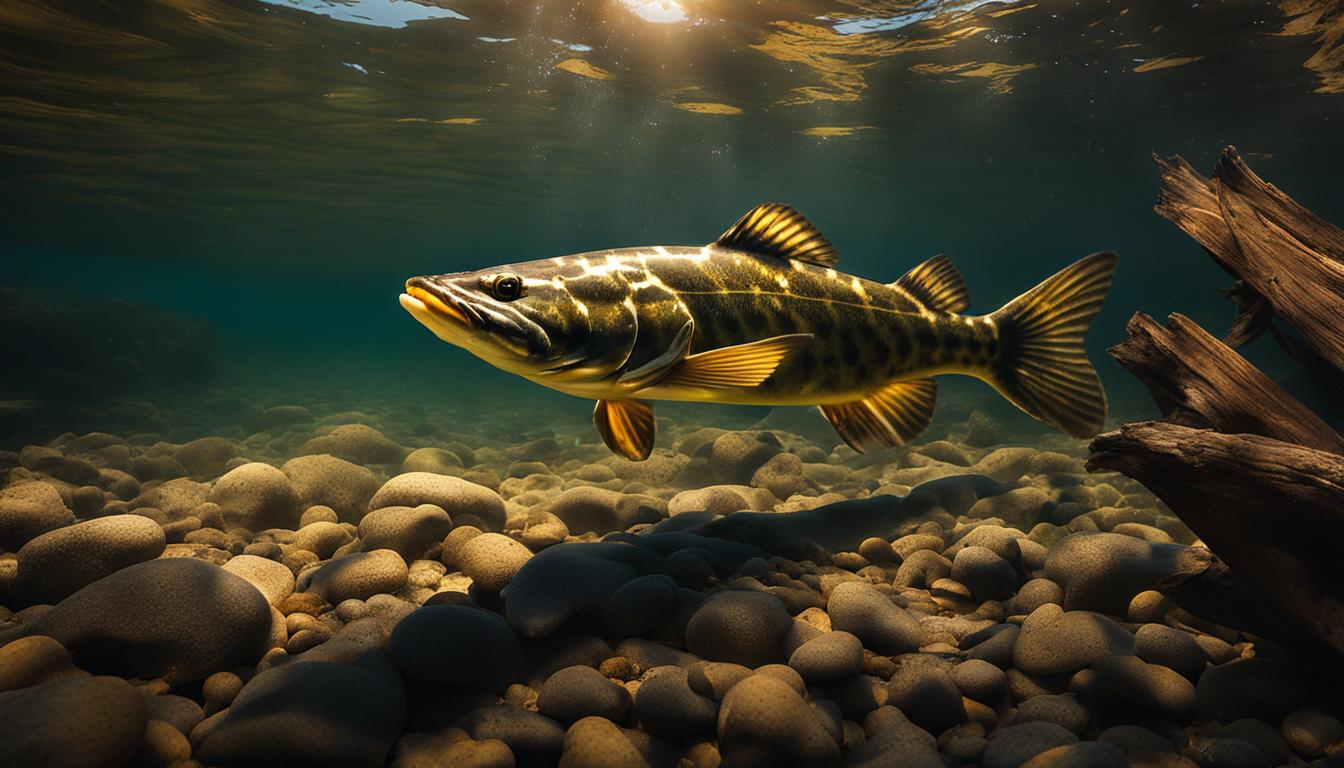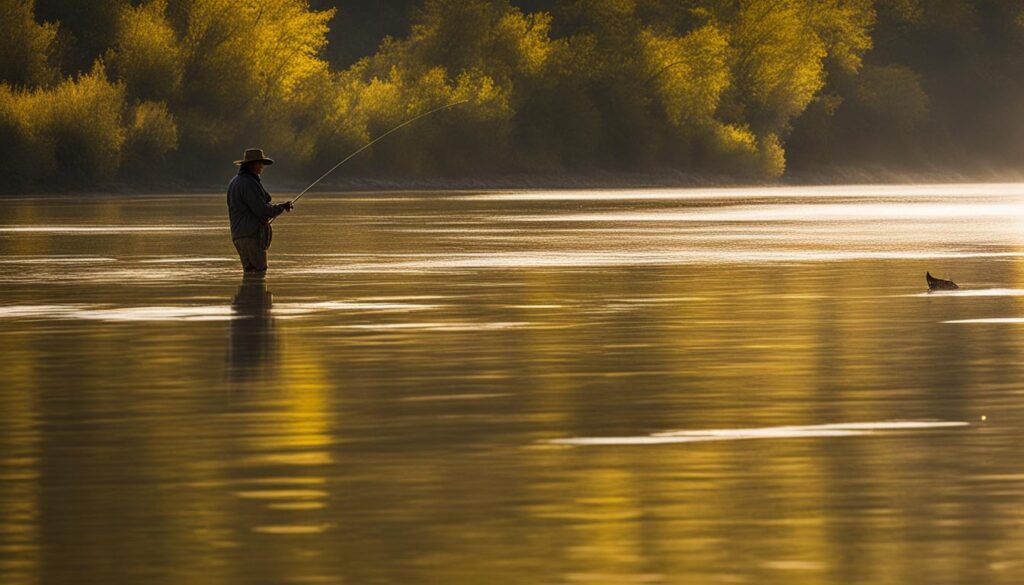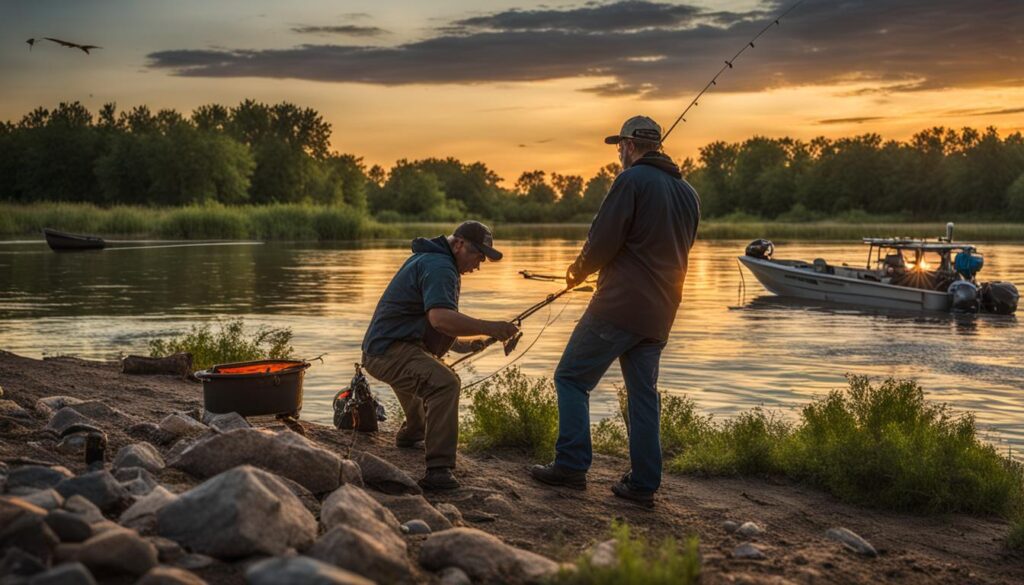
Discover the Thrill of Flathead Catfish in Kansas Rivers 2024
On December 14, 2023 by fishingamericatodayIf you’re a fishing enthusiast seeking an exhilarating adventure, look no further than the murky rivers of Kansas. Hidden beneath the surface, the flathead catfish awaits, offering a thrilling challenge for anglers of all skill levels. Despite the lack of attention and limited access, Kansas is renowned for its excellent flathead fishing opportunities. Whether you’re a seasoned angler or a novice fisherman, the Kansas rivers provide an abundance of flathead catfish just waiting to be caught.
Key Takeaways:
- Kansas rivers are known for their excellent flathead catfish fishing opportunities.
- The world-record flathead, weighing 123 pounds, was caught in Elk City Reservoir in 1998.
- Public-fishing opportunities can be found below the dams at Council Grove and John Redmond, as well as in city parks in various towns.
- Flathead catfish can be caught using various techniques such as rod and reel fishing, limb lines, trotlines, jugs, and handfishing.
- Handfishing season for flathead catfish in Kansas opens on June 15 and runs until August 31.
The Habitat and Food Sources for Flathead Catfish in Kansas
Flathead catfish thrive in the brush-filled, nutrient-rich rivers and reservoirs of southeast Kansas. These habitats provide the perfect environment for flatheads to grow and thrive. The catfish prefer areas with plenty of brush and snags for hiding during the day, as well as shallow areas and riffles for feeding at night.
The Neosho River, which starts in east-central Kansas and flows into northeast Oklahoma, is particularly renowned for its flathead catfish population. Anglers flock to this river, drawn by the abundance of flatheads and the exciting fishing opportunities it offers.
When it comes to their diet, flathead catfish are voracious eaters. They feed on a variety of prey, including shad, sunfish, crayfish, and other small fish. Their diet makes them opportunistic predators, capable of adapting to different food sources based on what is available in their environment.
Table: Common Prey of Flathead Catfish
| Prey | Description |
|---|---|
| Shad | Small, silvery fish that are a preferred food source for flatheads |
| Sunfish | Includes species like bluegill and pumpkinseed, provide a good source of nutrients |
| Crayfish | Aquatic crustaceans that serve as a tasty snack for flathead catfish |
| Other Small Fish | Includes minnows, darters, and other small fish found in the catfish’s habitat |
Understanding the habitat and food sources of flathead catfish is crucial for anglers looking to target these powerful fish in Kansas rivers. By knowing where they hide and what they eat, you can increase your chances of a successful catch. So grab your gear, head to the brush-filled rivers of Kansas, and experience the thrill of flathead catfish fishing in these fertile waters.
Best Fishing Spots and Access Points in Kansas
When it comes to flathead catfish fishing, Kansas offers a variety of excellent fishing spots and access points. Whether you’re a local angler or planning a fishing trip to the area, here are some top spots to consider:
Neosho River
The Neosho River, particularly renowned for its flathead catfish population, provides exceptional fishing opportunities. Access points can be found in various towns along the river, including Chetopa, Burlington, Iola, Chanute, and Oswego. These areas offer public fishing access and serve as gateways to the river’s tributaries, such as the Cottonwood River.
Kansas River
The Kansas River is another great fishing spot for flathead catfish enthusiasts. While access can be limited due to Kansas law granting landowners ownership of up to half of the stream bed, there are still public-fishing opportunities available. Below the dams at Council Grove and John Redmond, as well as in city parks, anglers can access the river and its thriving flathead catfish population.
Elk City Reservoir
Elk City Reservoir is worth mentioning for its historical significance in producing the world-record flathead catfish weighing 123 pounds. While fishing in reservoirs may offer a different experience compared to rivers, Elk City Reservoir remains a popular spot for flathead catfish enthusiasts.
Whether you choose to fish in rivers or reservoirs, it’s important to check local regulations and ensure you have the necessary permits before heading out. Many of these fishing spots may require a valid Kansas fishing license as well.

Expert Fishing Tips for Catching Flathead Catfish in Kansas
When it comes to catching flathead catfish in Kansas, there are a few expert fishing tips that can greatly increase your chances of success. Cade Johnson, a seasoned angler with years of experience, shares his insights into targeting these elusive fish.
Johnson recommends focusing on bends in the river where brush has piled up. These areas tend to attract flathead catfish, providing them with hiding spots and easy access to prey. By strategically positioning yourself near these brush-filled areas, you’ll increase your chances of a successful catch.
In terms of bait, Johnson suggests using live baits that mimic the natural prey of flathead catfish. Popular options include green sunfish, bullheads, and creek chubs. These baits have proven to be effective in luring flatheads out of their hiding spots and enticing them to bite.
When it comes to fishing techniques, Johnson recommends using rod and reel fishing techniques. This allows you to cast your bait precisely to target areas and gives you better control over the fight once a fish is hooked. Additionally, running trotlines can be effective during specific seasons, such as late September and October, when flatheads are feeding heavily in preparation for winter.
It’s important to note that before heading out to fish for flathead catfish in Kansas, you should familiarize yourself with the fishing regulations in the state. Obtain the necessary permits and ensure you are adhering to the guidelines set forth by the Kansas river fishing regulations. This will help to protect the fish population and ensure an enjoyable and sustainable fishing experience.
Expert Tips Summary:
- Target bends in the river where brush has piled up for better chances of finding flathead catfish.
- Use live bait such as green sunfish, bullheads, and creek chubs to entice flatheads.
- Utilize rod and reel fishing techniques for better precision and control.
- Consider running trotlines during peak feeding seasons.
- Follow Kansas river fishing regulations and obtain the necessary permits before fishing.
| Expert Fishing Tips for Catching Flathead Catfish in Kansas |
|---|
| Target bends in the river where brush has piled up |
| Use live bait such as green sunfish, bullheads, and creek chubs |
| Utilize rod and reel fishing techniques |
| Consider running trotlines during peak feeding seasons |
| Follow Kansas river fishing regulations and obtain the necessary permits |
Handfishing Season for Flathead Catfish in Kansas
If you’re an adventurous angler looking for a unique and thrilling fishing experience, then handfishing for flathead catfish in Kansas is just for you. This exciting fishing method, also known as noodling, allows you to catch flatheads using only your hands, without the use of hooks or manmade devices. The handfishing season in Kansas opens on June 15 and runs until August 31, providing ample opportunities to test your skills and catch some impressive catfish.
To participate in handfishing, you’ll need to obtain a special permit in addition to a regular fishing license. It’s important to note that during the handfishing season, only flathead catfish may be taken. This ensures the conservation of other fish species and maintains a balanced ecosystem.
Handfishing for flathead catfish can be both physically and mentally challenging. You’ll need to search for underwater cavities where flatheads may be hiding, such as under logs or in rock crevices. Once you locate a potential hiding spot, it’s time to reach in and try to coax the catfish out with your hands. Be prepared for a strong and vigorous fight as flatheads are known for their power and size.
Handfishing Safety Tips:
- Always have a fishing partner with you for safety purposes.
- Wear gloves to protect your hands from scales, sharp teeth, and possible injuries.
- Be cautious of underwater debris or rocks that could pose a safety risk.
- Never dive headfirst into the water when handfishing.
- Release any flathead catfish that are undersized or beyond your needs.
Handfishing for flathead catfish in Kansas offers an adrenaline-pumping and memorable fishing experience. It’s a chance to connect with nature in a unique way and test your fishing skills like never before. So, if you’re up for the challenge, grab your permit, gather your fishing gear, and head to the Kansas rivers for an unforgettable handfishing adventure.
Different Fishing Techniques for Catching Flathead Catfish
When it comes to catching flathead catfish, there are several fishing techniques you can try. Each method has its advantages and requires different gear and setups. Whether you prefer a more traditional approach or want to try something adventurous, here are some popular catfish fishing techniques you can explore:
Bank Poles
Bank poles are one of the simplest and oldest methods used to catch flathead catfish. It involves setting up a pole along the riverbank with a line and hook attached to it. Bait, such as live fish or cut bait, is placed on the hook. This technique is effective in slow-moving waters where flatheads frequent, and it allows you to cover a larger area without actively holding a fishing rod.
Limb Lines
Limb lines are similar to bank poles but are set up using tree limbs instead. You tie a line with a hook and bait to a sturdy overhanging limb, allowing the bait to hang just above the water surface. This technique is particularly useful in areas with plenty of overhanging trees, as it mimics the natural prey hanging above the water that flathead catfish feed on. Make sure to secure the limb lines properly and check them regularly to prevent fish from escaping or becoming entangled.
Trotlines
Trotlines are long lines with multiple hooks spaced at intervals. They are set across the waterway, typically anchored at both ends and supported by floaters. Bait is attached to each hook, and the trotline is left in the water for an extended period. This technique allows you to cover a larger area and target multiple flathead catfish simultaneously. Be sure to familiarize yourself with local fishing regulations and restrictions regarding the use of trotlines.
Jugs
Jug fishing involves using plastic jugs or bottles as floating devices with lines and hooks attached. The jugs are set afloat in the water, and the lines are left to drift. Flathead catfish are attracted to the movement and vibrations of the bait, making this technique effective in drawing their attention. Jug fishing is often a fun and social way to fish, as you can set out multiple jugs and wait for them to bob and signal a bite.
| Fishing Technique | Description |
|---|---|
| Rod and Reel Fishing | A more active method where you cast your line using a fishing rod and reel. It allows for precise bait placement and gives you better control over the fight when reeling in a catfish. |
| Noodling or Hand Fishing | An adrenaline-pumping technique where you use your bare hands to catch flathead catfish. This method involves locating catfish in their hiding spots, reaching in, and grabbing them by hand. It requires experience, caution, and knowledge of the catfish’s behavior. |
Remember, regardless of the fishing technique you choose, always follow local fishing regulations and obtain the necessary permits. Each state may have specific rules and restrictions, so it’s crucial to stay informed to ensure a responsible and enjoyable fishing experience.

Feeding Habits and Bait Selection for Flathead Catfish
Understanding the feeding habits and choosing the right bait are crucial elements to successfully catching flathead catfish in Kansas rivers. These opportunistic predators have a wide-ranging diet and can be enticed by a variety of live baitfish and other natural baits.
When targeting flathead catfish, it is important to use bait that is both appealing and readily available in their natural environment. Live baitfish such as shad, crappie, sunfish, and white bass are highly effective in attracting flatheads. These baitfish can be hooked whole or cut into chunks to entice the hungry catfish.
In addition to live baitfish, flathead catfish will also scavenge for food, making worms, crawfish, insects, and minnows viable options for bait. These natural baits can be used as a backup or alternative when live baitfish are not readily available.
Using common baitfish or chunks of baitfish is recommended when targeting flathead catfish.
Feeding Habits of Flathead Catfish
Flathead catfish are most active during the night, using their keen sense of smell and taste to locate prey. They are commonly found in deep, slow-moving pools of murky water during the day, using these areas as hiding spots. As night falls, flatheads venture out in search of food, often targeting areas with structures such as fallen trees, submerged brush, and other underwater obstacles.
These stealthy predators rely on their excellent sense of touch to detect vibrations and movement in the water, allowing them to locate potential meals even in low visibility conditions. Flatheads are known to be patient hunters, waiting and ambushing their prey before striking with lightning-fast speed.
With their strong jaws and sharp teeth, flathead catfish are capable of overpowering relatively large prey. Their feeding habits make them particularly intriguing targets for anglers, as they offer a thrilling challenge and the opportunity to catch impressive-sized fish.
| Bait Options | Effective | Availability |
|---|---|---|
| Live Shad | Yes | Seasonal |
| Live Crappie | Yes | Seasonal |
| Live Sunfish | Yes | Common |
| Live White Bass | Yes | Common |
| Worms | Yes | Common |
| Crawfish | Yes | Seasonal |
| Insects | Yes | Common |
| Minnows | Yes | Common |
Distribution and Lifespan of Flathead Catfish
Flathead catfish, also known as Pylodictis olivaris, can be found throughout the Mississippi River watershed and the lower Great Lakes region. They have also been introduced to various bodies of water outside their native range, often causing harm to other fish populations. These large freshwater fish are known for their ability to adapt and thrive in a variety of environments, making them a formidable predator.
The lifespan of a flathead catfish can vary, but on average, they live between 12 to 24 years. Some individual flatheads have been known to live up to 24 years, given the right conditions. These fish have a slow growth rate, with their size largely dependent on factors such as habitat, food availability, and competition from other fish species.
Table: Comparison of Flathead Catfish Distribution
| Location | Distribution |
|---|---|
| Mississippi River | Throughout the watershed |
| Great Lakes | Lower region |
| Introduced Waters | Various bodies of water outside native range |
Spawning for flathead catfish typically occurs in the spring when water temperatures rise. During this time, male catfish construct nests in shallow areas with gravel or sandy bottoms. The females lay their eggs in these nests, and the males guard and protect the eggs until they hatch. The young catfish then disperse into the surrounding waters and begin their journey towards adulthood.
Understanding the distribution and lifespan of flathead catfish can provide valuable insights into their behavior and population dynamics. It also highlights the importance of responsible management and conservation efforts to ensure the long-term sustainability of these fascinating fish species.
The Thrill and Benefits of Catching Flathead Catfish
When it comes to fishing, few experiences can match the thrill of catching a flathead catfish. These powerful and tenacious fish are known for their ability to put up a solid fight, providing anglers with an adrenaline-pumping battle. Whether you’re an experienced angler or just starting out, the challenge and excitement of reeling in a flathead catfish can make for a truly memorable fishing trip.
But the thrill of catching flathead catfish isn’t the only appeal. These fish are also highly prized for their delicious taste, making them a popular target for anglers who enjoy a fresh and flavorful meal. With their firm, white flesh, flathead catfish are perfect for grilling, frying, or baking. The size of these fish also means that they can provide several meals, especially when caught at larger sizes.
Another benefit of flathead catfish fishing is its accessibility. Unlike some other types of fishing that require specialized gear or expensive equipment, flathead catfish fishing can be enjoyed with basic fishing gear. All you need is a sturdy rod and reel, the right bait, and a few key techniques. This makes it a great option for anglers of all skill levels and budgets.
Fishing for Flathead Catfish
When it comes to catching flathead catfish, there are a few key tips to keep in mind. First and foremost, it’s important to select the right bait. Flathead catfish have a varied diet and are known to go after live baitfish such as shad, sunfish, and minnows. Using fresh, lively bait can greatly increase your chances of success.
Another important factor is choosing the right location. Flathead catfish are often found in deeper, slower-moving pools of water, particularly during the day when they seek out shelter. Look for areas with submerged logs, brush piles, or other cover where these fish are likely to hide. Casting your bait near these areas can attract hungry flathead catfish.
It’s also crucial to be patient and let the fish come to you. Flathead catfish are known to be opportunistic feeders, but they can be selective about when and where they strike. Give your bait enough time to attract their attention and be prepared for a slow and steady bite. Once you feel a bite, be ready for a fight, as flathead catfish are known for their strength and determination.
Table: Flathead Catfish Fishing Tips
| Tip | Description |
|---|---|
| Choose the right bait | Use live baitfish such as shad or sunfish to attract hungry flathead catfish. |
| Find the right location | Look for deeper pools of water with submerged logs or brush piles where flathead catfish are likely to hide. |
| Be patient | Wait for the fish to bite and be prepared for a slow and steady fight. |
So, if you’re looking for a thrilling fishing adventure that combines excitement, delicious meals, and accessibility, give flathead catfish fishing a try. Whether you’re casting your line in the rivers of Kansas or exploring other fishing spots, the thrill and benefits of catching flathead catfish are sure to make it a memorable experience.
Conclusion
Flathead catfish fishing in the Kansas rivers offers an exciting adventure for anglers seeking big fish action. Despite the challenges of access and limited infrastructure, the region’s murky waters are home to impressive populations of flathead catfish. With the right techniques and permits, you can experience the thrill of catching these giant fish and enjoy the bounty of delicious table fare they provide.
Catching flathead catfish can be a thrilling experience, with the fish putting up a solid fight. Flatheads are also prized for their delicious taste, making them a great food source. They can provide several meals, especially when caught at larger sizes. Flathead catfish fishing is accessible and doesn’t require extensive gear, making it a popular choice for anglers looking for an exciting and rewarding fishing experience.
Plan your next fishing trip to Kansas and discover the excitement of flathead catfish fishing in the heart of the Midwest.
FAQ
Where can I find the best flathead catfish fishing in Kansas?
The Neosho River and its tributaries, such as the Cottonwood River, offer excellent opportunities for flathead catfish fishing. Public-fishing areas below the dams at Council Grove and John Redmond, as well as city parks in towns like Chetopa, Burlington, Iola, Chanute, and Oswego, provide access to these fishing spots.
What are the best fishing techniques for catching flathead catfish in Kansas?
Rod and reel fishing, running trotlines, using bank poles, limb lines, jugs, and noodling or hand fishing are all effective techniques for catching flathead catfish in Kansas. Each method has its advantages and requires different gear and setups.
What is the handfishing season for flathead catfish in Kansas?
The handfishing season for flathead catfish in Kansas opens on June 15 and runs until August 31. During this time, anglers can catch flatheads using only their hands, without the use of hooks or manmade devices.
What bait should I use when targeting flathead catfish?
Flathead catfish are opportunistic feeders and will eat a variety of live baitfish, such as shad, crappie, sunfish, and white bass. Using common baitfish or chunks of baitfish is recommended when targeting flatheads.
Where can I access more information on Kansas river fishing regulations?
To ensure compliance with fishing regulations, including those specific to Kansas river fishing, it is recommended to visit the Kansas Department of Wildlife, Parks and Tourism website or contact their offices for the most up-to-date information.
Source Links
- https://ksoutdoors.com/KDWP-Info/News/News-Archive/2012-Weekly-News/6-14-12/FLATHEAD-CATFISH-HANDFISHING-SEASON-JUNE-15-AUG.-31
- https://catfishnow.com/MAG/2022/09/15/big-kansas-flatheads/
- https://n1outdoors.com/flathead-catfish/
Archives
Calendar
| S | M | T | W | T | F | S |
|---|---|---|---|---|---|---|
| 1 | 2 | |||||
| 3 | 4 | 5 | 6 | 7 | 8 | 9 |
| 10 | 11 | 12 | 13 | 14 | 15 | 16 |
| 17 | 18 | 19 | 20 | 21 | 22 | 23 |
| 24 | 25 | 26 | 27 | 28 | 29 | 30 |
| 31 | ||||||
